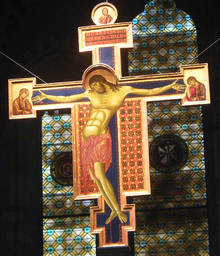San Domenico (Arezzo)
San Domenico is a church in the Tuscan city of Arezzo . The Gothic building dates from the 13th century and is considered one of the most impressive mendicant churches in Tuscany. It contains significant frescoes and the earliest surviving work by Cimabue . The church has the rank of minor basilica .
Location and name
The church is located on the northern edge of the old town of Arezzo, about 250 meters north-northwest of the Church of San Francesco . There is a small square in front of it, where the Via di San Domenico , named after her, runs past.
The church was built by Dominicans and therefore takes its name from its founder, St. Dominic .
Building history
Construction began in 1275, and the Dominicans had been present in Arezzo since 1236. The plans for this may have been worked out by Dominicans from Florence , the assumption is related to the similarity of the central choir chapel with that of the Church of Santa Maria Novella , which is only a few decades older. In the 16th and 17th centuries, the church was given a baroque style to match the taste of the time and the late medieval frescoes were whitewashed. These fixtures have been removed over the past few decades and the frescoes, as far as they could be saved, have been made visible again and restored.
facade
The facade dates from the original construction period. Although it is not perfect and of the greatest possible simplicity, it is still considered original and noble. It has three axes, with pilaster strips dividing the wall, a round window breaking through the surface of the central axis. The left axis is slightly bevelled, the right one serves as a tower wall with an open bell cage . The small porch of the portal is modern.
Basic structure and interior
In terms of its basic structure, it is a further simplification of the church buildings of the Cistercians . The church is single-nave and has no transept . The choir is flanked on both sides by a smaller choir chapels . It is covered with a groin vault, but the nave has no vaults, so that the wooden roof structure can be seen open.
Frescoes
Following the idea of the popular sermon of the mendicant orders , the church was richly frescoed. The artists were local and influenced by Giotto's frescoes .
On the inside left of the portal wall is the fresco Saints Philip and James . The saints themselves are depicted, with scenes from their lives next to each other. The bezel contains two side-by-side representations: the mystical engagement and the martyrdom of St. Catherine of Alexandria . The fresco is painted in the soft style and comes from Spinello Aretino , around the year 1400.
The right inner side of the portal wall contains a representation of the crucifixion , Saint Dominic as the patron saint of the church and Saint Nicholas of Bari are depicted, scenes from his life are shown in the lunette. The fresco comes from Spinello Aretino's son, Parri di Spinello , and was made in the late Soft Style around 1440.
On the south side there is another crucifixion scene with St. John Ev. and the Archangel Michael . The frescoes by Giovanni d'Agnolo di Balduccio (not to be confused with Balduccio ) date from around 1430.
The Gothic tabernacle on the right wall of the nave was made around 1368 by Giovanni di Francesco from Florence. The frescos for this are again by Spinello Aretino, he created an Annunciation scene around 1385 , as well as works by Gregorio and Donato d'Arezzo . They worked the fresco Jesus among the scribes in the 14th century.
Crucifix of the Cimabue
Cimabue created the magnificent, larger than life crucifix before the church was built, between around 1260 and 1270. It is painted with tempera on a wooden panel. A similar crucifix by him was lost in the flood disaster in Florence in 1966 in the church of Santa Croce , so this is the only surviving work from his early days. The crucified is shown in a slight S-curve and thus follows the Gothic style of representation. With his bowed head he belongs to the iconographic type of the suffering Christ . In addition, the style of various details, such as the physiognomy or the loincloth, indicates influences of Byzantine art, but goes well beyond these with the indicated plasticity of the body. His mother Mary and St. John are shown in corner pictures on the arms of the cross. Above the crucified one is a bust of the same in a round shape.
Individual evidence
- ↑ a b c d e Zimmermanns: Toscana - The hill country and the historic city centers , p. 234.
- ↑ a b Schomann: Art Monuments in Tuscany , p. 384.
- ^ A b Dispute: Florence - Tuscany - Umbria, Land of the Etruscans , p. 156.
- ↑ a b c Schomann: Art Monuments in Tuscany , p. 385.
literature
- Heinz Schomann: Art Monuments in Tuscany , Scientific Book Society , Darmstadt 1990
- Klaus Zimmermanns: Toscana - The hill country and the historic city centers , Cologne 2011, pp. 246–247. ISBN 3-7701-1050-1
- Conrad Streit: Florence - Tuscany - Umbria, Land of the Etruscans , Walter-Verlag, Olten and Freiburg im Breisgau 1972 (special edition for the Scientific Book Society Darmstadt)
Web links
Coordinates: 43 ° 28 ′ 8.7 " N , 11 ° 52 ′ 55.3" E

